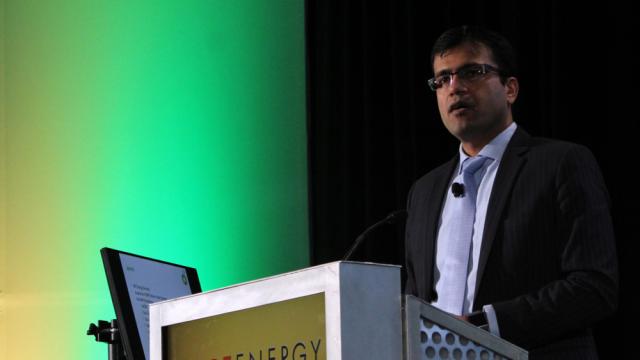
Mohit Singh, senior vice president of business development and exploration for BPX Energy, says the company is on its way to building a premiere onshore business in the U.S. (Source: Velda Addison/Hart Energy)
SHREVEPORT, La.—It’s not uncommon for British supermajor BP Plc to publicly share information on its operations; however, its Lower 48 business—the recently christened BPX Energy—rarely makes such moves.
That changed when Mohit Singh, senior vice president of business development and exploration for BPX Energy, took the stage at Hart Energy’s DUG Haynesville Conference & Exhibition on Feb. 20. He spoke about how BP is transforming its U.S. onshore business, following its $10.5 billion acquisition of BHP Billiton’s Delaware Basin, Eagle Ford and Haynesville assets in 2018.
“For me to come out [on stage] was a little bit of a coming out party in some sense,” Singh said. “One of the things we want to do going forward is be a little bit more visible externally so we can get our message out.”
Starting March 1, the company will take over operations from BHP on its quest to build a “premier independent onshore company focused on delivering free cash flow on a consistent basis,” Singh said.
The acquisition, which closed in October 2018, marked a pivotal moment for BP, which already had U.S. onshore assets that include the Midcontinent’s SWOOP, Anadarko and Arkoma as well as East Texas, San Juan and Wamsutter assets. The assets are among the $5 million to $6 million worth of property BP plans to divest over the next two years to pay for its acquisition of BHP’s U.S. shale assets.
Referring to BPX’s legacy portfolio, Singh said the company had several good opportunities prior to the acquisition, “but BHP clearly upgrades us. … We’re talking about decades and decades of high quality drilling inventory that will deliver phenomenal rates of return.”
The deal includes assets in the Permian’s Delaware Basin, adding about 41,000 barrels of oil equivalent per day (boe/d) in production with 3,390 gross drilling locations on an 83,000-acre position.
“We are seeing up to 240 rig years of drilling inventory just because of the stacked pay zones,” Singh said, particularly in the Bone Springs and Wolfcamp A, B and C/D. The company put the after-tax internal rate of returns for the assets at between 28% and 50%.
The deal also gives BPX an opportunity to develop multilaterals in Eagle Ford benches and Austin Chalk. The acquired assets in the liquids-rich Eagle Ford included core acreage in the Karnes Trough and the shale play’s wet gas window, Singh said. Current production is about 87,000 boe/d (71% liquids), and there are 1,402 gross drilling locations on the 201,000-acre position.
In the Haynesville, BPX tripled its footprint and doubled its production with the BHP deal. Singh said BPX is running six rigs in the Haynesville in East Texas this year and has plans to eventually start on the Louisiana side.
Once BP completes divestitures, which are being offered in seven packages, Singh said BPX will only operate in the Delaware, Eagle Ford and Haynesville.
“That’s where all of the capital will go. Traditionally, we’ve spent about $1 billion of capital in this business every year,” Singh said. “Going forward, that number will be $2-$2.5 billion. It’s significant investment by BP into the onshore business.”
Meanwhile, marketing has already begun for assets being sold by BP.
“Suffice it to say the last 18 months at BP have been very, very hectic but a good kind of hectic,” Singh said.
The Shallow Woodford Oklahoma Oil Play (SWOOP) near the Scoop and Stack plays and East Texas packages are already being marketed. The others, Singh said, are set to come out between the end of February and early March.
The biggest of the bunch are the San Juan Basin assets, which accounts for half of the nearly 200,000 boe/d of production being sold. Singh described San Juan as a “phenomenally robust play in terms of coal.” Most of the production comes from coal seams in San Juan, he said, calling it world-class quality coal.
Here, BPX has drilled horizontal semi-laterals, dual laterals, tri laterals and quad laterals, which Singh described as horizontals coming from one vertical on a pad. Such drilling methods have enabled BPX to reduce well costs, he added. Plus, “given the quality of the coal is so prolific, these wells come on and they stay flat for a year plus, which is incredible.”
BPX produced about 100,000 boe/d from the San Juan Basin in 2018. Most of it was gas.
However, some oily acreage is also available, including in the SWOOP where BPX said well results have been strong.
“We were running four rigs prior to BHP happening. We were very, very bullish on this play,” Singh said before highlighting IPs of nearly 90% oil. “Hopefully, it will end in the hands of someone who’s going to get after it.”
Other assets available include the:
· Glenwood, Woodlawn and Oak Hill fields in East Texas, which comprise about 45,000 mostly contiguous acres. BPX says there are development and recompletion opportunities in the Cotton Valley, Haynesville and other horizons;
· Wamsutter in the Northern Greater Green River Basin, where the company said “existing cash flow from liquids-rich low decline base production complements horizontal redevelopment of Lewis and Almond;”
· Two large core gas positions in the Arkoma, where there is undeveloped horizontal potential in the Woodford Shale; and
· Anadarko Basin, a more than 500,000-acre position that Singh said might be divided into three packages.
BP is also divesting interest in legacy mineral and leaseholds in nonoperated assets in several basins, including Powder River, Williston, Eagle Ford, Haynesville, Stack/Scoop and Denver-Julesburg.
Post-integration in 2021, BPX Energy expects to have 3,500 wells, down from 9,400 in 2018, and operate in three basins, down from six.
But the capital budget is expected to more than double as the company focuses heavily on the Delaware, Eagle Ford and Haynesville to bring combined production to about 500,000 boe/d, up from 315,000 boe/d in 2018. Oil is expected to make up about 25% of BPX’s production mix, compared to 5% in 2018, as the company remains bullish on gas.
The acquisition of BHP’s U.S. shale assets has been transformational, Singh said.
“It’s given us very high rates of return and a depth of repeatable drilling inventory that is very, very exciting. … We are well on our way to building a premiere onshore business,” he said.
Velda Addison can be reached at vaddison@hartenergy.com.
Recommended Reading
Deep Well Services, CNX Launch JV AutoSep Technologies
2024-04-25 - AutoSep Technologies, a joint venture between Deep Well Services and CNX Resources, will provide automated conventional flowback operations to the oil and gas industry.
EQT Sees Clear Path to $5B in Potential Divestments
2024-04-24 - EQT Corp. executives said that an April deal with Equinor has been a catalyst for talks with potential buyers as the company looks to shed debt for its Equitrans Midstream acquisition.
Matador Hoards Dry Powder for Potential M&A, Adds Delaware Acreage
2024-04-24 - Delaware-focused E&P Matador Resources is growing oil production, expanding midstream capacity, keeping debt low and hunting for M&A opportunities.
TotalEnergies, Vanguard Renewables Form RNG JV in US
2024-04-24 - Total Energies and Vanguard Renewable’s equally owned joint venture initially aims to advance 10 RNG projects into construction during the next 12 months.
Sitio Royalties Dives Deeper in D-J with $150MM Acquisition
2024-02-29 - Sitio Royalties is deepening its roots in the D-J Basin with a $150 million acquisition—citing regulatory certainty over future development activity in Colorado.






